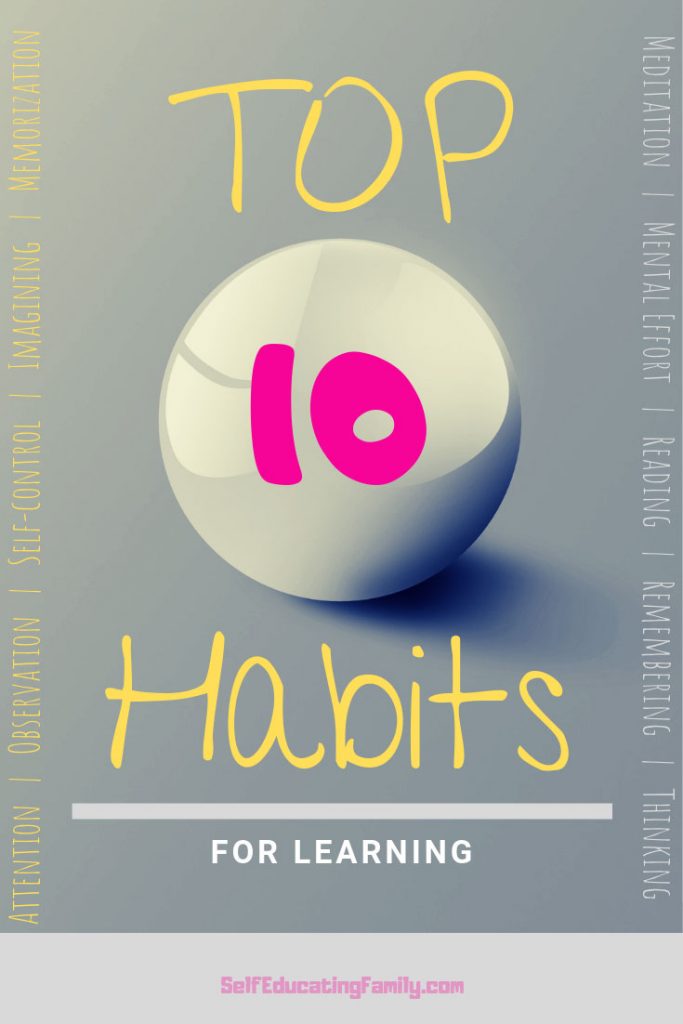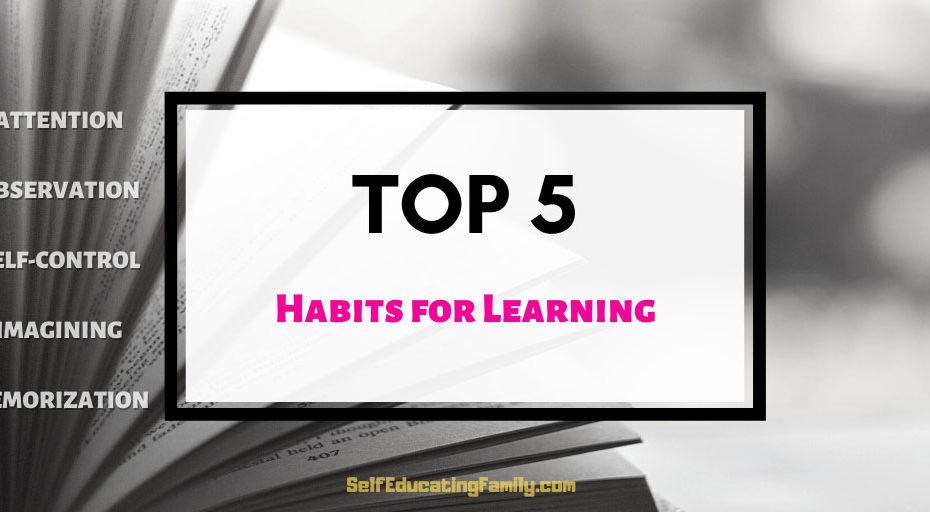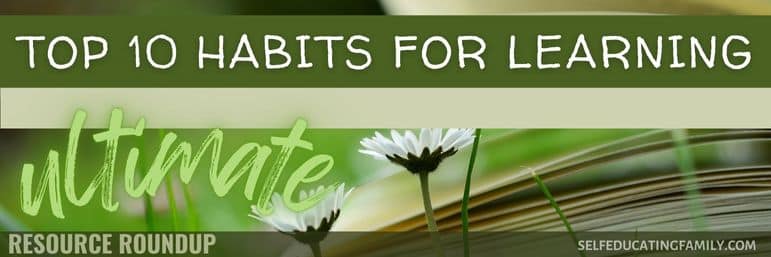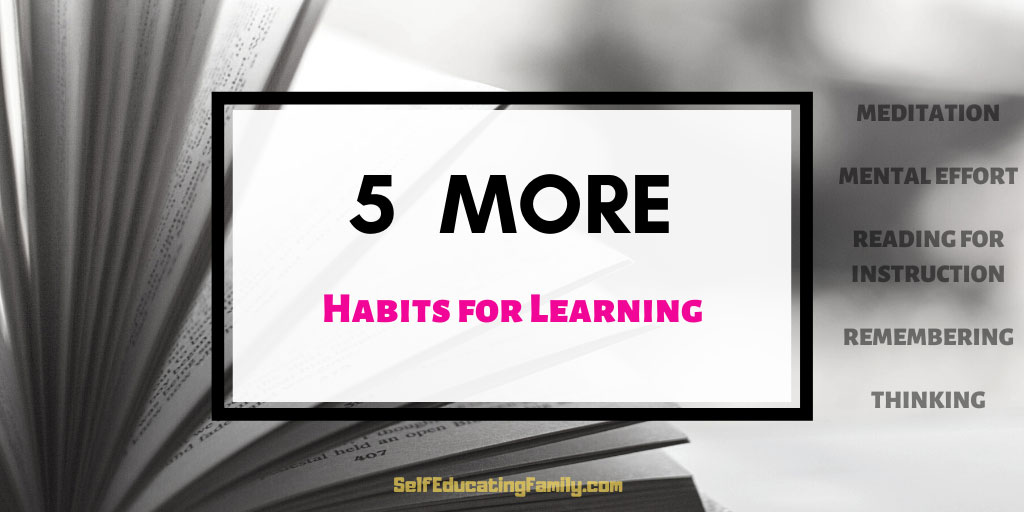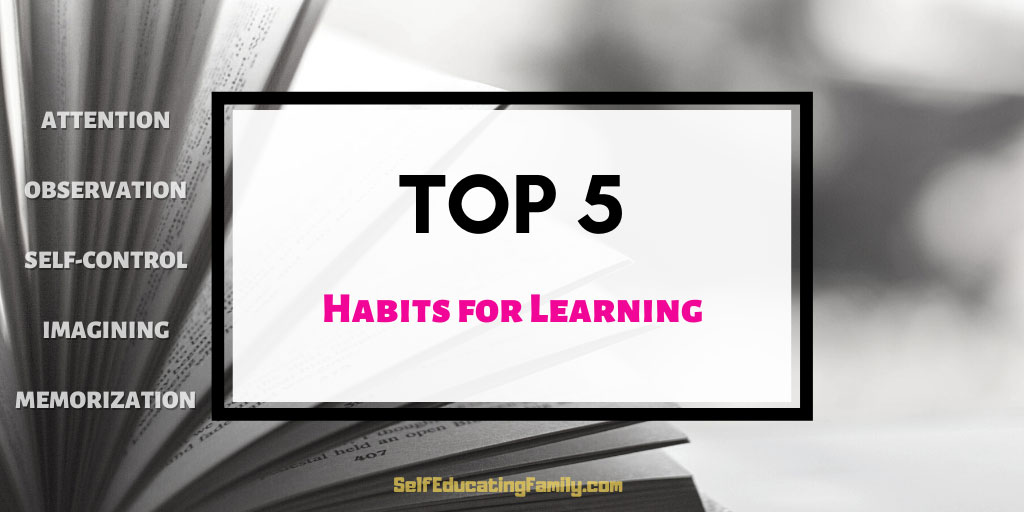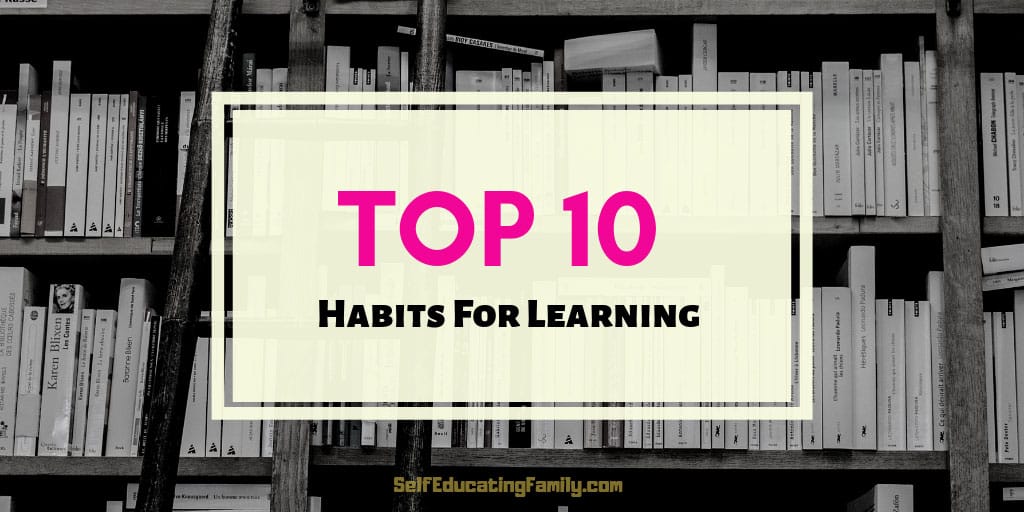This is Part 2 of Top 10 Habits for Learning
In this article, I’ve gathered the practical and motivational resources to help you form your top 10 essential habits for learning. And I’ve split up the information since there is a lot to say. Today, we cover Building the Foundation: Basics.
This second post in the 3-part series will detail resources for the five top learning habits that you need to make learning second nature. Before reading this, be sure to familiarize yourself with the overview of habit formation in the first post in this series.
- 1: Overview of Top 10 Habits for Learning
- 2: Build the Foundation: Basic Habits for Learning (this article)
- 3: Grow Your Brain: Advanced Habits for Learning
Top 10 Habits for Learning
So, what follows is an in-depth look at the top 5 of my recommended top 10 habits to acquire to be a better learner. Habits 6 through 10 are discussed in Part 3 of this series.
- Attention
- Observation
- Self-control
- Imagining
- Memorization
- Meditation
- Mental effort
- Reading for instruction (vs. just loving to read)
- Remembering
- Thinking
Essential Habits for learning
I mentioned in the overview post, that all of these habits are essential for learning, but the first five: attention, observation, self-control, imagining, and memorization, provide the foundation and can be practiced even by young children.
Additionally, the second five: meditation, mental effort, reading for instruction, remembering, and thinking, will build on the first five.
So what follows in this article is a look at the practical application of acquiring each of the first five basic habits for learning. I’ll also describe what each habit looks like.
1. Attention
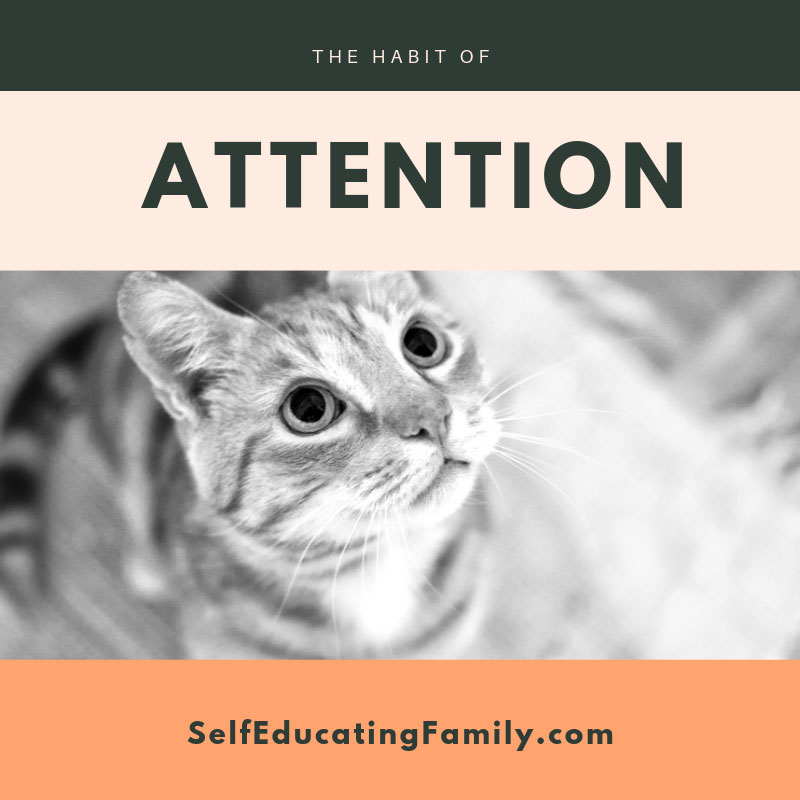
Many people talk about the habit of attention, since Charlotte Mason (CM) emphasized it so much. She considered it a key to smooth days. CM defined it as using your “whole metal force” for what you were doing:
“Attention is hardly even an operation of the mind, but is simply the act by which the whole mental force is applied to the subject in hand. This act, of bringing the whole mind to bear, may be trained into a habit at the will of the parent or teacher, who attracts and holds the child’s attention by means of a sufficient motive.”
Charlotte Mason Series, Volume 1, p. 145
Attention Resources
There’s so much to say about attention and how it relates to learning. Here are some good starting resources:
Sonya Shafer at Simply Charlotte Mason provides an excellent article on the mental habits suggested by CM. She goes into a lot of detail on the habit of attention since it is so foundational.
Another resource is Brandy at Afterthoughts. She looks at the habit of attention on Day 18 of her 31 Days of Charlotte Mason series. She humbly gives what she calls “a good start” on ideas for cultivating this habit.
Naomi at Living Minca discusses the whys, as well as offers practical tips towards the bottom of the article, starting with “Some things we can do to help the child develop the habit of attention…”
Leah at My Little Robins gives an excellent overview on how to train the habit of attention. For practical tips for younger kids, scroll down to the section “Attention with Little Ones.”
For a fun listening game that can increase attention span, get the download from this article.
Finally, Heidi Miller-Ford from The Unexpected Homeschooler graciously wrote a guest post for me on using short lessons. She describes how short lessons can help build the habit of attention.
2. Observation
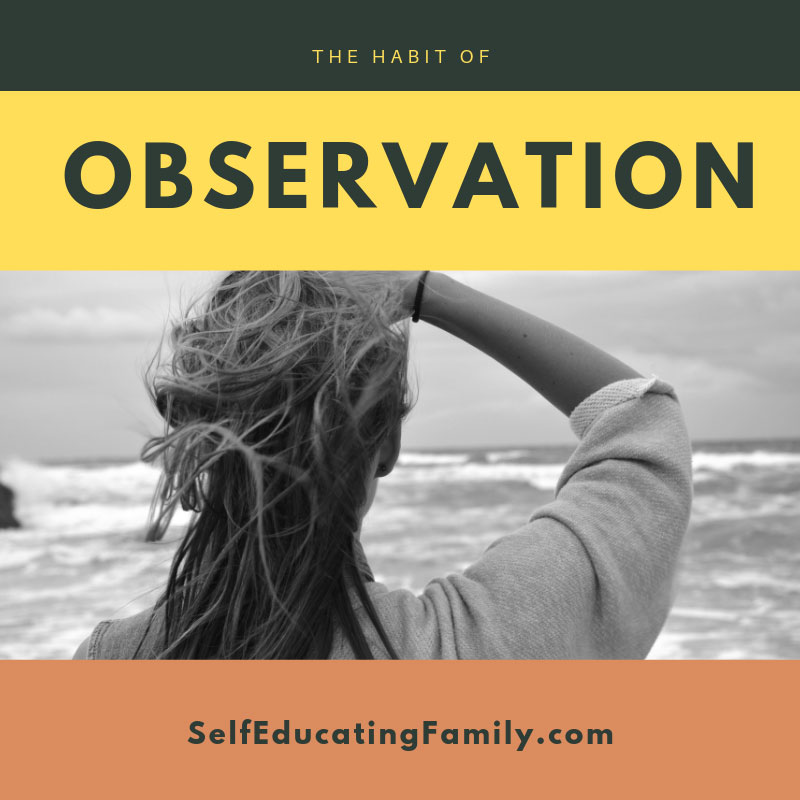
The habit of observation is essential in many of the activities that are “Charlotte Mason-esque” – like nature study or artist study, for instance. Observation follows attention and is simply so necessary to everything we learn.
Sight-seeing
CM describes how to play a game of “sight-seeing” with children to train their observation skills.
“While wits are fresh and eyes are keen, [the mother] sends them off on an exploring expedition––Who can see the most, and tell the most, about yonder hillock or brook, hedge, or copse. This is an exercise that delights children, and may be endlessly varied, carried on in the spirit of a game, and yet with the exactness and carefulness of a lesson.”
Charlotte Mason Series, Volume 1, pp. 45-46.
You may not see “yonder hillock” while on your nature walks, but the principle can certainly be applied today. If your children enjoy it, I’d recommend playing this game for 10 minutes now and then on your walks with all ages of children. Or reverse the game and have your kids see how much you observe.
Practice is key
Attentive practice in short bursts over time is a key here, but be sure to vary it up each time. You can even use it as a 5-minute break during the day, which works especially well with short lessons – “Who can run outside and tell me everything about what the weather (sky, trees, wind, sun, etc.) is doing?” If you are stuck inside and need a break, “Can you tell me everything you notice about the ceiling if you are lying on the floor?” This suggestion offers so many options! Put it in your toolbox to use regularly.
Observation Resources
In brief, here’s some of my favorite discussions on the topic.
Joy at Artful Homemaking covers the basics of nature study with 3 simple ways to get started.
Cindy from the Art Class Curator discusses picture study in a guest post at Real Life at Home with some wonderfully practical and approachable instructions.
Katherine Prince from Raising Princes has a guest post on InspiretheMom that covers 5 ways to incorporate the habit into daily activities.
PlayDiscoverLearn has such a wonderful take on using the habit of observation for math skills that I had to include it here.
And lastly, from Sonya at Simply Charlotte Mason: A great post on 5 Habits Built into a CM Education, including Observation.
3. Self-control
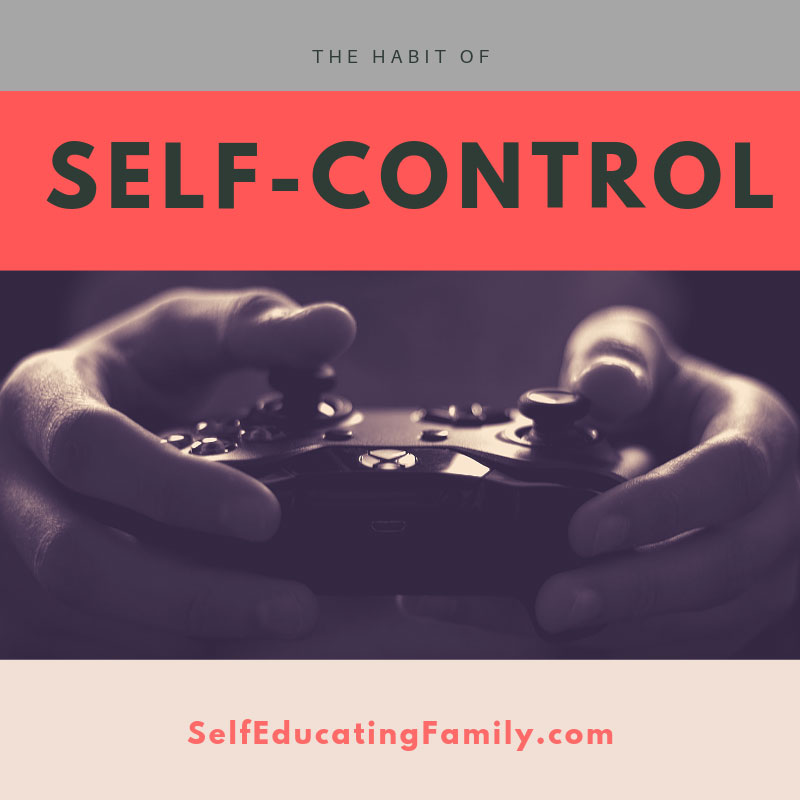
Self-control might seem unrelated to learning, but self-mastery implies being able to direct your own self towards your personal goals.
Aristotle said, “What lies in our power to do, it lies in our power not to do.” And Horace said, “Rule your mind or it will rule you.”
The habit of attention comes into play again here: CM also believed that as a young person was trained in the habit of attention, they would eventually govern themselves to be attentive. In other words, they can learn to govern themselves using self-control.
“As the child gets older, he is taught to bring his own will to bear; to make himself attend in spite of the most inviting suggestions from without. He should be taught to feel a certain triumph in compelling himself to fix his thoughts.”
Charlotte Mason Series, Volume 1, p. 145
Self-Control Resources
Six tips on how to increase your habit of self-control by Forbes.
While there are some good general resources, there’s not much out there specifically aimed at teaching the habit of self-control, but Dana at Train up a Child has a good general reference article. In it, she mentions some key areas for self-control for younger kids where we need to be “cultivating a tolerant, pleasant, patient attitude instead of being quick to whine or complain when conditions aren’t exactly as we’d like them.” Come to think of it, all ages could use a little more of that no-complaining aspect of self-control.
A fascinating look at beating the famous marshmallow test and brain neuroplasticity suggests that playing particular games with preschoolers regularly can strengthen their resolve in resisting the marshmallow.
The Marshmallow Test: Can a young kid use delayed gratification?
And finally, IMom has some more tips on teaching patience and self-control.
4. Imagining

Imagination might seem unrelated to learning, but we are creative creatures. According to Wabisabi Learning, “Imagination is considered the faculty or action of forming new ideas or concepts of external objects not present to the senses.”
Sparking imagination can spark learning. Ironically, there’s a lot of talk about how to do this in today’s education system. Charlotte Mason is once again before her time! She naturally suggests cultivating this basic habit for learning through the use of living books. She describes tales of the imagination as “scenes laid in other lands and other times, heroic adventures, hairbreadth escapes, delicious fairy tales in which they are never roughly pulled up by the impossible––even where all is impossible, and they know it, and yet believe.”
Linda at Charlotte Mason Help has some interesting thoughts on what NOT to do to help increase imagination – spoiler: it involves NOT watching TV! A good reminder for myself that “twaddle” comes in many forms!
Interestingly, Leah at My Little Robins recommends Geography studies and stories to fuel the imagination. And she lists some practical ideas to bring the subject to life.
Another key: living books
And if we think about it, the imagination is where stories and ideas begin to take hold. Feed the mind with the stories and the learner makes connections. Living books are a key.
Wendi at Wendi Wanders gives a summary of her talk given at AO Camp called “Imagination.” Here’s a great quote, “Accurate observation builds imagination. Picture to yourself the story. It builds a web of knowledge (not linear, stacked facts).”
Fuel the imagination with Picture Study
Picture study is also good for the imagination according to CM. Rebecca at A Humble Place quotes CM, “imagination has the property of magical expansion, the more it holds the more it will hold.”
Brandy at Afterthoughts also details how picture study fuels the imagination on Day 28 of her 31 Days of Charlotte Mason.
5. Memorization
In times past, our schooling culture, as well as many other cultures, routinely expected children to memorize large amounts of information. CM used recitation of Poetry, Hymns, Folk Songs and Bible verses to build the habit of memory.
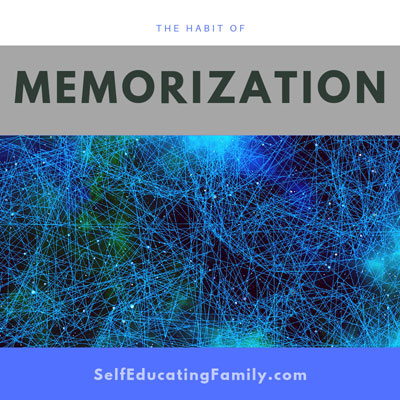
Recitation
Charlotte Mason used recitation liberally – but the purpose was not to increase a child’s capacity for memorization. Her methods have a very natural way of doing things that are good for our brains. Her purpose in recitation was to fill the child’s head with beautiful thoughts. By reciting the material, a child gained the bonus by-product of increased ability to memorize.
Notice what CM advocated memorizing – lyrical or poetic pieces. Not lists, like “the countries of the world in reverse populous order” or “103 Chronological Movie Minifigures.” Not that I don’t love lists.
So we see that memorization is not the end goal of recitation in strict Charlotte Mason methodology, but will often come as a by-product of using the technique of recitation. Randi at Nourished Children describes the details of how to do a recitation lesson. She also has some thorough lists on additional resources.
Maria Bell wrote a very thorough examination of the why’s and how’s of Charlotte Mason ideas about recitation for Charlotte Mason Poetry. She wrote that recitation provides a method of a “habit of committing to memory ‘without labor.’”
Foreign Language?
And here’s an interesting idea… Anne at Language Learning at Home recommends using foreign language as a memory muscle stretcher.
Ultimate Guide to Memorization
But if you are looking for interesting ideas on memorizing as a habit, Pam Barnhill at Homeschool Solutions seems to have compiled the ultimate guide to memory work – oh, wait – that’s exactly what it is called! And she’s not kidding – it is very thorough. And I like her “Number 1 tip” to keep it fun.
Basics of the Top 10 habits for learning
To summarize, this article should give you some starting ideas of where to learn more about the basic habits for learning: attention, observation, self-control, imagining, and memorization. These provide a solid foundation for learning and can even be started at an early age. You can even work on them as an adult!
This is the second article in a series on habits for learning. If you missed the discussion on how I came up with these top 10 habits, be sure to check out Part 1 in this series:
Finally, if you are ready for the more advanced habits that build on the solid foundation described in this post, head over to Part 3 for a look at meditation, mental effort, reading for instruction, remembering, and thinking.
Recap of 10 habits to acquire to be a Better Learner
- Attention
- Observation
- Self-control
- Imagining
- Memorization
- Meditation
- Mental effort
- Reading for instruction (vs. just loving to read)
- Remembering
- Thinking
Look for a summary of the resources mentioned in all three posts in our Ultimate Roundup of Resources for the Top 10 Learning Habits.
